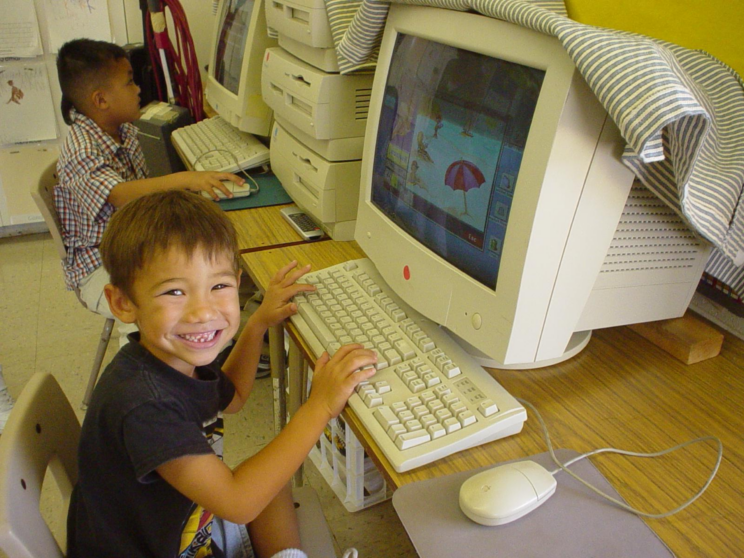Ho'opa'a: Technology, Language and Basic Educational Successes for Hawaiian Children and Youth with Disabilities

Project Dates: 2005 – 2008
Funded by: AOD; Other MCHB; Other HRSA Funds; OESE
About
Ethnic minorities, people with disabilities, and people with poverty incomes are finding themselves more likely to miss out on opportunities leading to success at school and in the workplace. Hawaiian children with disabilities are among those with the lowest measured skills in today’s technology, literacy, and mathematics. Across the US, the least literate adults have the least income, and jobs increasingly require technology skills. Hawaiian children and youth with disabilities need basic academics and pride in their culture to succeed. To improve education and outcomes, our project seeks to boost literacy, math, technology skills, and use of Hawaiian language through evidence based methods. Children and youth will increase self-efficacy and enjoy their educational experiences.
The goals are:
- Infuse Hawaiian culture and language into currently proven and promising educational supplements. We have devised and established a family of ACE (Actual Community Empowerment) literacy and technology programs in agencies and schools. These programs have proved effective and enjoyable for all ages of children (with and without disability designations) in a wide range of Pacific region cultures. For school settings, our project will serve 390 participants (357 being Hawaiian); 60 students classified as having a disability, and 200 at risk. In non-school educational settings, such as a community technology center that has after school programs, we will serve 2748 participants (1279 being Hawaiian and 237 classified with a disability). A panel of Hawaiian experts will adapt these programs for cultural infusion and implementation in two public charter schools and three after school programs that are based on indigenous Hawaiian education.
- Implement a menu of programs in six sites. The curriculum includes technology, reading and writing, mathematics, and Hawaiian language. The ACE programs provide project-based learning (in a full inclusion setting) of computer software and other technologies, relevant–even essential–to success in today’s world. Artful ACE and TeenACE teach reading, comprehension, and writing through cultural strengths and multimedia software. The Memory Game (new software) supports these activities and is particularly suited to teaching vocabulary of different languages.
- Apply a Community Response Model a) to improve outcomes; b) to increase the extent to which Hawaiian culture drives the processes. The Community Response Model includes participant observation and the ongoing revision of each program in each setting. Measures will include computer mastery from keyboarding and word processing to art and web construction, reading fluency, comprehension, English and Hawaiian vocabulary, basic math fluency and problem solving. Interviews and focus groups (by an independent evaluator) will help identify strengths and program improvements.
- Improve self-efficacy and self-determination, individually and culturally, through the discovery that education can be enjoyable, with a sense of high rates of success. Through Video Futures, at-risk youth and students with disabilities will learn to create self modeling videos for peers and younger children. They will improve transitions, technical skills, social skills, and provide or receive mentoring.
- Ensure adequate training and materials of teachers and paraprofessionals. We will train and mentor current staff at participating schools. These staff will assist the dissemination and community networking, training of local partners, and establish other self-sustaining resources, such as self-guiding manuals, videos, webpages, and protocols for future trainers/coordinators. The collaborative system will promote opportunities to share best practices, strategies and local expertise.
Outcomes are:
- Ka Waihona: Three activities were offered: (1) Computer ACE serving students reading at K-3 level, (2) ACE serving student sreading at 3rd-6th grade level ability, (3) ACE Puzzles for students performing at 4th grade level math. Participants are tutored by Waianae High School students and a few from neighboring Nanakuli High School Hawaiian reading books are available, and students have easy access to a wide variety of reading materials.
- Hawaiian Language is incorprated as much as possible during tutoring activities – tutors speak Hawaiian to give simple instructions whnen the session begins and end. Hawaiian language is also used for the memory interactive word game children play at the end of the session. Common and new Hawaiian words are inserted in memory cards during the activity so students learn and develop both their English and Hawaiian vocabulary (Memory Games). Students were reported making connections ni meaning of wordsthrough learning both English and Hawaiian vocabularies.
- Hale Pono: ACE tutoring is offered from Monday to Friday at the library of the Boys and Girls Clubhouse. Tutors are recruited from the Teen Center, a separate program in the Boys and Girls Clubhouse. Tutees come from neighboring feeder elementary and intermediate schools in Ewa Beach community. Students learn common and new Hawaiian vocabulary words during each session. Tutoring offers reading assistance to some of the students that are reading below grade level in the regular classroom setting. The site coordinator enriches the ACE Reading implementation by incorporating Hawaiian music and vocabularies learned by students to fun interactive tutoring sessions.
Partner
- Halau Ku Mana New Century Charter School
- Ka Wai Hona New Century Charter School
- Boys and Girls Clubs (Hale Pono/Papakolea
- Palama Settlement Community Center
- Ohana Komputer


